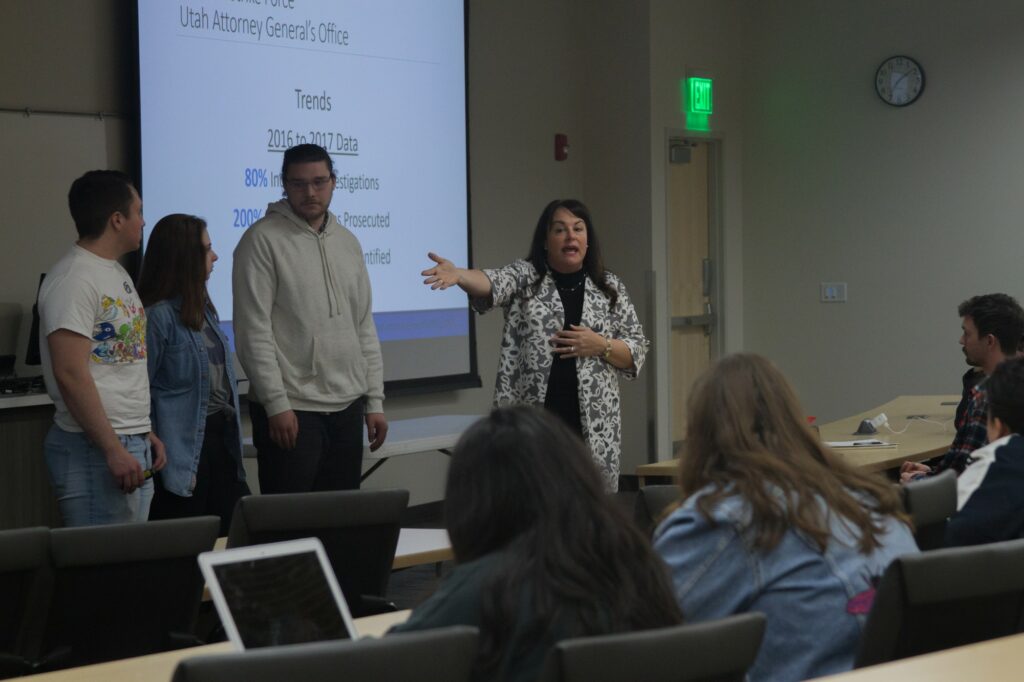
The youngest human trafficking victim in Utah is 9 years old. While many do not want to believe these things occur in their backyard, human trafficking is not exclusive to third world countries.
Allison Smith, education and outreach specialist for the Trafficking in Persons Program with the Refugee and Immigrant Center in Salt Lake City, spoke about human trafficking to WSU students and Ogden community members for Women’s History Month.
Smith said 73 percent of people acknowledge human trafficking is widespread in the U.S., but 20 percent recognize that it happens within their community.
According to Fox 13, Lynnsie Reddish and Terrance Jones, an Ogden couple, were sentenced one to 15 years in prison on Jan. 2018. The couple ran a “long-term sex trafficking operation” and were charged with 16 felony offenses.
Trafficking is surrounded by myths: “It couldn’t happen in my town” or “all trafficking cases are women bound by the hands.” These myths are not only false but lead to misinformed communities that cannot identify cases of trafficking when it’s right before their eyes.
The National Human Trafficking Resource Center Hotline identified more than 24,000 cases of human trafficking in the U.S. between Sept. 2012 and Sept. 2016. Of those, 13 percent of cases were men.
Generally, most of the public believes human trafficking occurs only when a man kidnaps a woman against her will, takes her to a different country and sells her. However, trafficking often happens between people who know and trust each other.
Sex trafficking recruitment tactics include false promises of a lucrative job, stability, education or a loving relationship, according to The Polaris Project. Intimate partners expose their counterparts to this world under the guise of a financial stable future. Parents have trafficked their children for money or drugs.
Smith compared sex and drug trafficking, saying traffickers do what they can to make the most money. Drug traffickers will push suppliers for more product. Sex traffickers, on average, sell victims 25 times a day.
Marginalized people are frequently targeted for trafficking, including the homeless, runaways, members of the LGBTQ+ community, refugees and immigrants.
Some human trafficking victims do not see themselves as victims and believe it was their choice. Some victims do not leave if the opportunity arises, due largely to trauma bonding.
“In order to survive traumatic experiences, our brain’s neurobiology actually changes. It is a neurobiological coping mechanism, trauma bond,” Smith said. “The goal of the brain is to increase the person’s sense of safety while decreasing their sense of pain.”
According to Smith, human trafficking has gone from the third largest illicit industry in the U.S. to the second, and it is rapidly approaching first.
Maria Oxandabarat, a WSU freshman, is learning about human trafficking in a women and gender studies class. She attended the lecture to see how she could help and get involved in the Ogden community to enact change.
“I pictured trafficking as something that is far away and not close to home,” Oxandabarat said. “Human trafficking can happen anywhere. It’s overwhelming that we don’t talk about this stuff enough.”
Stephanie Speicher, WSU assistant professor, told attendees to educate their friends, family and community.
“Be willing and open to share what you learned tonight. Knowledge is power,” Speicher said.
If you or someone you know needs help or you want to report a tip, call the National Human Trafficking Hotline at 888-3737-888.


















